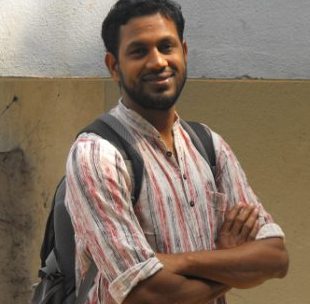Vruttant Manwatkar
 It has now been quite a few days since the demise of Raja Dhale, a Revolutionary Leader of the movement of Justice, Liberty, Equality, and Fraternity. His death suddenly brought back a plethora of critical developments in the form of intimate memories associated with him. My pen wouldn’t have forgiven my mind if I hadn’t contributed my reflective tribute on the occasion of this crucial event. Thus, while remembering Leader Dhale on the occasion of his death, here is my attempt to throw light on some very necessary issues of the movement about which Leader Dhale had been immensely serious and conscious.
It has now been quite a few days since the demise of Raja Dhale, a Revolutionary Leader of the movement of Justice, Liberty, Equality, and Fraternity. His death suddenly brought back a plethora of critical developments in the form of intimate memories associated with him. My pen wouldn’t have forgiven my mind if I hadn’t contributed my reflective tribute on the occasion of this crucial event. Thus, while remembering Leader Dhale on the occasion of his death, here is my attempt to throw light on some very necessary issues of the movement about which Leader Dhale had been immensely serious and conscious.
Deaths of revolutionaries are full of creative power to produce and facilitate human freedom. Similarly, the final adieu of Leader Dhale to our material world sparked the beginning of a forgotten debate which Dhale presented in the form of ‘Anti-Dalitism’- the way to end mental and social slavery. His activism and literary engagements comprise of a scathing and consistent attack on Brahmanical Hegemony. He had also been dedicated and persistent in his endeavours to organise masses to construct a Just and Egalitarian society.
The trajectory of Leader Dhale’s contribution to our society constitutes revolutionary insights and socio-political activities. The formation of radical movement ‘Dalit Panther’, Organisation of people in the trail-blazing ‘Mass Movement’, Leadership in the Republican Party, relentless production of ‘Samatawadi’ literature, etc. marked his ever-ready presence for the welfare and benefit of the masses.
However, it is very regrettable to witness the trend that continuously tries to force Leader Dhale’s vision and work only in the frame of ‘Dalitism’ and ‘Dalit Panthers’. One can easily identify this trend, particularly in the tributes that appeared in various forms after his death. A blatant example is of a public discussion called by BAPSA (Birsa Ambedkar Phule Students Association), JNU.1 The public meeting was called remembering Raja Dhale to discuss the subject – ‘Dalit Panthers: Reading its Consciousness’. There’s no doubt that a discussion in Leader Dhale’s memory is welcoming. But, remembering Leader Dhale only to discuss ‘Dalit Panthers and its Consciousness’ is majoritarian and erroneous bereft of the requisite critical outlook. Like BAPSA, several other individuals and organisations too did fall to this error. It is majoritarian because the majority of the people, perhaps all of them, remembered and recalled him by naming him ‘Panther Dhale’ or a leader of the ‘Dalit Panther’ movement.2, 3 Similarly, it is erroneous because ‘Dalit Panther’ is not the only concern to remember the revolutionary life of Leader Dhale. A qualitative error lies in reducing him to a mere ‘Dalit Panther’ for he was not only the leader who attacked on the ideological foundations of ‘Dalit Panther’ but also challenged and questioned the moral integrity of his then fellow Panther leaders, especially Namdeo Dhasal.

Leader Dhale’s discursive location is clearly manifested in the disagreement he maintained with Namdeo Dhasal who was one of his close associates in the formation of Dalit Panthers. This disagreement took a concrete form in 1973, while the Dalit Panther Manifesto was in making. Substantiating his ideological disagreement, Leader Dhale outrightly rejected the Dalit Panther Manifesto by calling it “Namyacha Jahirnama” (Namdeo’s Manifesto) not “Panthercha Jahirnama” (Panther’s Manifesto). He refuted the ideology of the Manifesto by identifying it as a Communist document which failed the purpose for which the Panthers were organised.
One of the most striking attacks that Leader Dhale made on the foundations of the ‘Dalit Panther’ is evident in his sharp and uncompromising criticism of the moral integrity of Namdeo Dhasal and his like- the proponents of militant radicalism. While doing this, he went to the extent of making piercing statements like “Kahi Loka Chalvalit Jagtat ani Kahi Loka Chalvalinvar Jagtat” (Some Persons Live in Movements and Some Persons make a Living out of Movements). He had never been afraid to point out the names of those people who served their own self-interests and sold their integrity to the oppressor class.

Poster of the Public Discussion called by BAPSA
‘Dalit Panther’ played a pivotal role in the construction of the popular ‘Dalit’ identity to challenge Brahmanism. Nonetheless, after realising the wrongs of ‘Dalitism’ of Panthers, Leader Dhale vehemently opposed the ‘Dalit’ identity. He still stands apart as an iconoclast from the political leaders who have been cunning enough to sell the ‘Dalit’ identity in the mainstream Manuist market.
Exceedingly, after consciously rejecting the identity of ‘Dalit’ as well as ‘Panther’, Leader Dhale identified himself as a ‘Buddhist’. He also spearheaded the idea of naming the movement as a ‘Phule-Ambedkarite Movement’ instead of calling it a ‘Dalit Movement’. In this context, it is an injustice to label him ‘Dalit’ or ‘Panther’.
Leader Dhale had been a progressive person who dared to destroy the identity for its irrelevance, which perhaps, he himself had constructed. Unlike the political leaders who develop an unreasoned attachment for the organisations they form, Leader Dhale stood apart as a progressive leader who cared for people’s welfare rather than his own organisation. His writings depict a progression similar to his inspiration Dr. Ambedkar. From Yeru, Atta, Tapasi, and Vidroh to Jatak, Samadrushti, Chakravartin, Dhammalipi and Dhammachakra, the ideological formulation in the nomenclature of his writings symbolises an Ambedkarite progress. His early writings were volatile and emphasised discontent while the later ones exhibited radical equanimity representing the revolution of The Buddha and His Dhamma. Leader Dhale’s participation and leadership in several organisations of Dhamma-Deeksha Ceremonies also exhibited his principled dedication in the Ambedkarite method of human freedom from the slavery of oppressor class.
Dr. Ambedkar in his legendary speech ‘Annihilation of Caste’ presented an insight regarding the nature of the oppressor class in India vis-a-vis its engagement in the movement to annihilate the Caste system. According to him “The Brahmins form the vanguard of the movement for political reform and in some cases also of economic reform. But they are not to be found even as camp-followers in the army raised to break down the barricades of Caste.”
Furthermore, while giving a befitting response to the question “Is there any hope of the Brahmins ever taking up a lead in the future in this matter?”, Dr. Ambedkar concluded “NO”. Babasaheb also maintained that “it is useless to make a distinction between the secular Brahmins and priestly Brahmins. Both are kith and kin. They are two arms of the same body and one bound to fight for the existence of the other.”
Now, in this context, let me problematise the disagreement between Leader Dhale and Namdeo Dhasal. Let me pose a few questions – Why did secular Brahmins like P. L Deshpande and Vijay Tendulkar applaud the communist romanticism of Namdeo Dhasal? And, why didn’t the Ambedkarite approach of Leader Dhale receive any engagement form this class? Shouldn’t the positive engagement of secular Brahmin communists and their love towards Dalitism be considered while judging the capacity of ‘Dalitism’ to annihilate Caste? Was the clear stand of Leader Dhale against ‘Dalitism’ an apparent threat to Brahmin Supremacy? Why the secular Brahmins have had an ideological intimacy with ‘Dalitism’ propagated by Dhasal, whereas being indifferent or apathetic towards ‘Ambedkarite’ ideas propagated by Leader Dhale?
So far the lives of the marginalised, oppressed and the depressed classes of India are concerned, the present socio-political situation is disturbing. Moreover, the growing fashion among the youth to commodify the ‘Dalit’ identity via victimisation is alarming. The supremacist market is feeding to the self-interests of these ambitious youth from the marginalised sections who earn handsome profits by selling the victimizing, demeaning and discouraging ‘Dalit’ identity. Thus, in these circumstances, Leader Dhale’s revolutionary legacy of ‘Ambedkarism’ would prove to be a beacon of light to guide the torch bearers of Justice and Equality.
Summing up, I must say that it is not possible to present a complete account of Leader Raja Dhale’s contribution in this brief essay. I have attempted to emphasise the less-discussed but very significant aspect of his ideological and practical legacy. He lived and died as a dignified stalwart of the critical legacy of Lord Buddha, Kabir, the Phules and Dr. Ambedkar. By comparing with his romantic counterpart, one of my major tasks is to present the realist vision of Leader Dhale with which he aimed for human freedom through the Ambedkarite method of the Eightfold Path. He had been a fierce opponent of ‘Dalitism’ and a firm proponent of ‘Ambedkarism’. Thus, especially in the current appalling socio-political scenario where the popular victimising discourse of ‘Dalitism’ is fuelled by Liberal-secular-brahminism, Leader Dhale’s legacy of ‘Anti-Dalitism’ needs an urgent attention, engagement as well as propagation.
References
1. ‘Dalit Panthers: Reading its Consciousness’, Public Discussion organised by BAPSA, JNU. Speakers – Dr. Harish Wankhede, Dr. Sharad Baviskar, Dr. Pradeep Shinde and Participating Scholars.
2. In Conversation with Raja Dhale, Youtube, Vidya Bhushan Rawat.
3. Raja Dhale, a Firebrand Anti Caste Leader Who Rebelled Against the Normative, The Wire, Sukanya Santha
~~~










